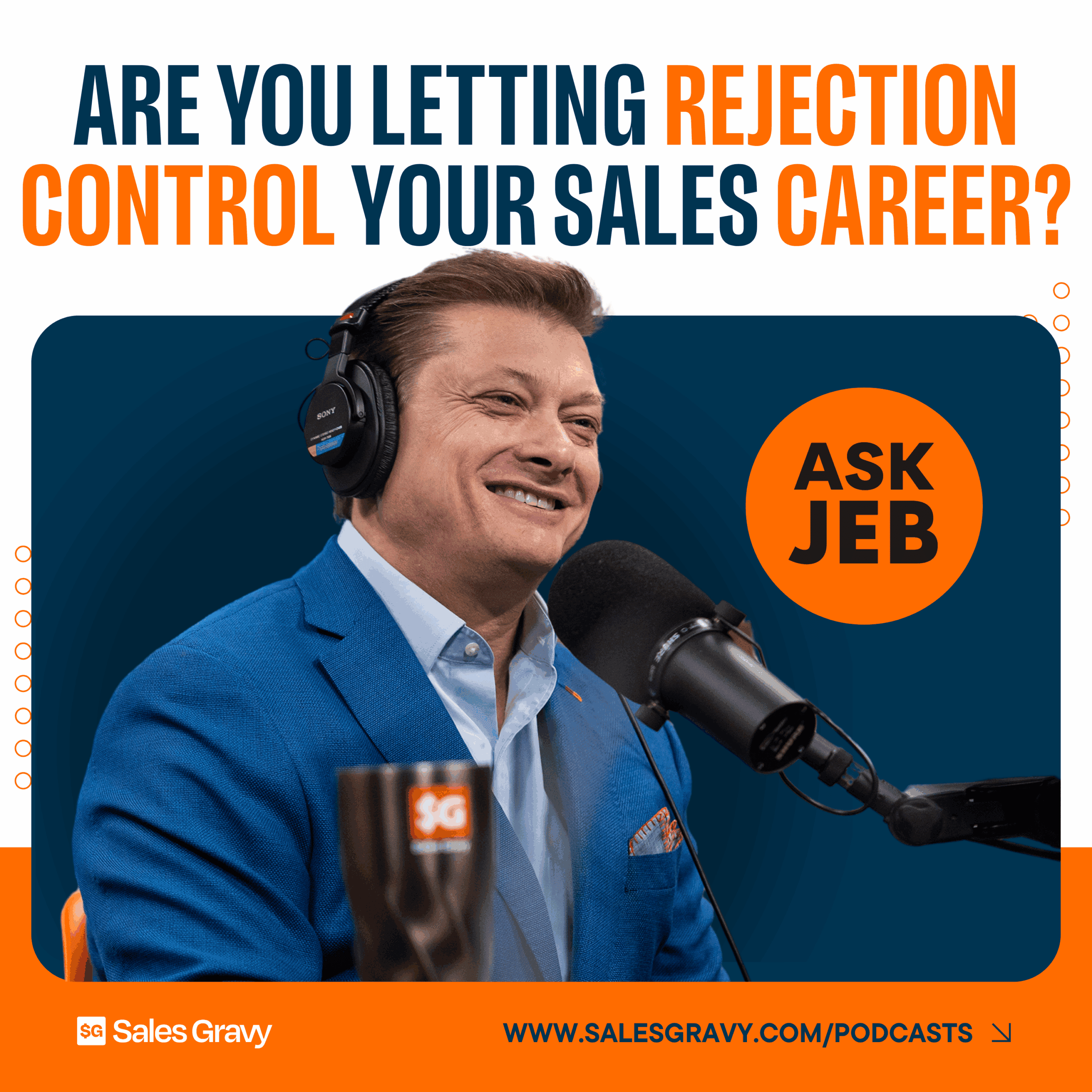Why Your Best SDRs Burn Out by Month Four — And How to Stop It
Update: 2025-11-13
Description
To a sales leader, it’s a familiar story.
Month one: Your new SDR is on fire. Energy through the roof. They’re excited about cold calling.
Month two: Still strong. Meetings are getting booked. Dashboard looks good.
Month three: Cracks appear. Rejections pile up. But they hang in.
Month four: Burnout.
The dials drop. The energy’s gone. That superstar you hired 90 days ago is updating their LinkedIn profile—and you know exactly what that means. Now you’re back in hiring mode, your team’s pipeline is slipping, and your recruiting budget just took another hit.
But it’s not that the SDR role is broken—the system is. Sales teams are great at starting fast and terrible at sustaining it. People get thrown in with a script and a quota, celebrate quick wins, then act surprised when burnout becomes inevitable.
Tim Hester, VP of Sales Development at Alliance HCM, leads one of the fastest-promoting SDR teams in the industry. His team survives month four and keeps thriving. Some SDRs promote out in 60 days. Others stay because they’re growing, not just grinding.
It’s a tactical framework that stops inefficiency.
The Problem: You’re Forcing SDRs to Run Without a Finish Line
When Tim inherited his SDR team, he saw the pattern immediately. One SDR position. No progression. No momentum. Just grind.
Talented people hit quota, kept hitting quota, and then started asking themselves: Why am I still doing the exact same job six months later? “Just wait your turn” doesn’t cut it anymore. Maybe it never did.
The wake-up call came when Tim realized something critical: The things that kill SDR motivation aren’t trainable.
Work ethic. Mindset. How someone approaches their day and prospecting blocks. That’s character. You can’t coach it in a workshop. Tim tried way too many times before figuring that out.
You can teach someone objection handling. You can show them how to use the CRM. But if there’s no light at the end of the tunnel, no amount of training fixes that. That’s on leadership, not the rep.
The Solution: Build a Roadmap That Rewards Performance, Not Tenure
Tim flipped the script on how SDR performance gets measured and rewarded. He created tiered SDR levels based purely on performance thresholds. Not tenure. Not politics. Not “when a spot opens up.”
The roadmap has clear levels: from new SDR to quota-hitting SDR to exceeding SDR who now trains the team. Each level comes with a comp bump and more responsibility. Most importantly, it proves effort matters.
This framework ensures that when your reps look at the dashboard, they see a clear, actionable path for progression. It’s the sales leader’s job to ensure that dashboard clarity is tied directly to the next level.
The impact is immediate. Reps see exactly what they need to level up. There’s no waiting for someone to quit so that a spot opens. Those who want to move fast can; those who need more time have a clear path, too.
This framework changed recruiting entirely. Tim could tell candidates on day one: People move up at their own rate; you control your trajectory at this company.
Suddenly, the SDR role wasn’t a holding pattern. It was a launchpad.
The Dashboard: Four Metrics That Actually Matter
Metrics are your scoreboard. If your reps don’t trust the score, they stop playing hard.
When Tim took over, the dashboard was a mess. Crowded with metrics nobody understood or trusted. Reps tuned it out because they didn’t know what half the numbers meant or how they connected to their success.
Tim stripped it down to four metrics:
Dials – Shows effort and how they’re working the database. Everyone can pick up the phone.
Connections – Only counts conversations with decision-makers. Not gatekeepers. Not assistants. This shows outreach quality.
Meetings Scheduled – The conversion from connection to meeting. This is where you see who’s actually selling.
Meetings Ran – If they don’t show up, what’s the point?
For Tim, the most important is the latter three because of their impact. He’s measuring what drives meetings and revenue. Simple. Clear. Actionable. No vanity metrics.
The Training: Start with Mechanics.
Most companies try to turn SDRs into product experts on day one. Tim does the opposite.
He breaks training into three buckets:
Mechanics – CRM management, using the dialer, and objection handling. These are fundamental basics that must be mastered before there can be further movement.
Knowledge – Developing an ICP and persona basics. Narrow and focused. Build your knowledge on the people who matter.
Art – The intangible skills that develop over time as reps sit in on meetings and watch demos.
Setting that expectation allows reps to move fast. It might not be the straightest line, but they’re executing, gaining confidence, and booking meetings in week two instead of week eight.
SDRs aren’t closing six-figure deals. They’re scheduling introductory meetings and bringing in the account executive who has the expertise to close. Expecting perfect performance on day one slows ramps and kills confidence. Employ mechanics first and let the art follow.
The Mindset: Small Changes, Big Impact
Before Tim was a leader, he spent too much time searching for the silver bullet. He’d toss the whole playbook after one bad call, desperately seeking the one "secret" that would make prospecting easy.
His breakthrough was realizing his job as a leader wasn't to teach the art of the perfect call, but to build the system that rewarded consistent effort.
Now, he drills this into his team: consistency. It's a direct result of the structure he built. Reps commit to consistency because they know the roadmap proves that their small daily progress will compound into a promotion.
The commitment to consistency starts during onboarding. By clearly presenting the tiered performance levels and the four key metrics on day one, leadership sets the expectation that results are driven by process, not luck. When the path is clear, reps stop searching for a shortcut.
Consistency beats flash every time. Average SDRs become consistent producers. Consistent producers become top performers. The system is the guarantee that their consistency will pay off.
Month Four Doesn’t Have to Be the End
The SDR graveyard isn’t full of lazy people; it's full of frustrated talent who were put on a treadmill when they needed a ladder. By month four, a high-performer has mastered the basics and is staring at the ceiling. Same script. Same job. Same quota. They burn out from futility, not from effort.
Tim Hester's approach stops this cycle. He proves that the only way out is up.
Clear metrics keep the focus sharp.
Tiered levels create propulsion.
A performance-driven roadmap ensures reps know they control their destiny.
The question every sales leader must ask is: "What message does our system send on day one?"
Empower your reps with a plan they can believe in, and your top talent will be busy working toward their next title, not updating their resume.
Your roadmap gives your SDRs the path, but they still need the tactics to fill their calendar and earn that promotion. Download Sales Gravy's 25 Ways to Ask for the Appointment on a Cold Call guide.
Month one: Your new SDR is on fire. Energy through the roof. They’re excited about cold calling.
Month two: Still strong. Meetings are getting booked. Dashboard looks good.
Month three: Cracks appear. Rejections pile up. But they hang in.
Month four: Burnout.
The dials drop. The energy’s gone. That superstar you hired 90 days ago is updating their LinkedIn profile—and you know exactly what that means. Now you’re back in hiring mode, your team’s pipeline is slipping, and your recruiting budget just took another hit.
But it’s not that the SDR role is broken—the system is. Sales teams are great at starting fast and terrible at sustaining it. People get thrown in with a script and a quota, celebrate quick wins, then act surprised when burnout becomes inevitable.
Tim Hester, VP of Sales Development at Alliance HCM, leads one of the fastest-promoting SDR teams in the industry. His team survives month four and keeps thriving. Some SDRs promote out in 60 days. Others stay because they’re growing, not just grinding.
It’s a tactical framework that stops inefficiency.
The Problem: You’re Forcing SDRs to Run Without a Finish Line
When Tim inherited his SDR team, he saw the pattern immediately. One SDR position. No progression. No momentum. Just grind.
Talented people hit quota, kept hitting quota, and then started asking themselves: Why am I still doing the exact same job six months later? “Just wait your turn” doesn’t cut it anymore. Maybe it never did.
The wake-up call came when Tim realized something critical: The things that kill SDR motivation aren’t trainable.
Work ethic. Mindset. How someone approaches their day and prospecting blocks. That’s character. You can’t coach it in a workshop. Tim tried way too many times before figuring that out.
You can teach someone objection handling. You can show them how to use the CRM. But if there’s no light at the end of the tunnel, no amount of training fixes that. That’s on leadership, not the rep.
The Solution: Build a Roadmap That Rewards Performance, Not Tenure
Tim flipped the script on how SDR performance gets measured and rewarded. He created tiered SDR levels based purely on performance thresholds. Not tenure. Not politics. Not “when a spot opens up.”
The roadmap has clear levels: from new SDR to quota-hitting SDR to exceeding SDR who now trains the team. Each level comes with a comp bump and more responsibility. Most importantly, it proves effort matters.
This framework ensures that when your reps look at the dashboard, they see a clear, actionable path for progression. It’s the sales leader’s job to ensure that dashboard clarity is tied directly to the next level.
The impact is immediate. Reps see exactly what they need to level up. There’s no waiting for someone to quit so that a spot opens. Those who want to move fast can; those who need more time have a clear path, too.
This framework changed recruiting entirely. Tim could tell candidates on day one: People move up at their own rate; you control your trajectory at this company.
Suddenly, the SDR role wasn’t a holding pattern. It was a launchpad.
The Dashboard: Four Metrics That Actually Matter
Metrics are your scoreboard. If your reps don’t trust the score, they stop playing hard.
When Tim took over, the dashboard was a mess. Crowded with metrics nobody understood or trusted. Reps tuned it out because they didn’t know what half the numbers meant or how they connected to their success.
Tim stripped it down to four metrics:
Dials – Shows effort and how they’re working the database. Everyone can pick up the phone.
Connections – Only counts conversations with decision-makers. Not gatekeepers. Not assistants. This shows outreach quality.
Meetings Scheduled – The conversion from connection to meeting. This is where you see who’s actually selling.
Meetings Ran – If they don’t show up, what’s the point?
For Tim, the most important is the latter three because of their impact. He’s measuring what drives meetings and revenue. Simple. Clear. Actionable. No vanity metrics.
The Training: Start with Mechanics.
Most companies try to turn SDRs into product experts on day one. Tim does the opposite.
He breaks training into three buckets:
Mechanics – CRM management, using the dialer, and objection handling. These are fundamental basics that must be mastered before there can be further movement.
Knowledge – Developing an ICP and persona basics. Narrow and focused. Build your knowledge on the people who matter.
Art – The intangible skills that develop over time as reps sit in on meetings and watch demos.
Setting that expectation allows reps to move fast. It might not be the straightest line, but they’re executing, gaining confidence, and booking meetings in week two instead of week eight.
SDRs aren’t closing six-figure deals. They’re scheduling introductory meetings and bringing in the account executive who has the expertise to close. Expecting perfect performance on day one slows ramps and kills confidence. Employ mechanics first and let the art follow.
The Mindset: Small Changes, Big Impact
Before Tim was a leader, he spent too much time searching for the silver bullet. He’d toss the whole playbook after one bad call, desperately seeking the one "secret" that would make prospecting easy.
His breakthrough was realizing his job as a leader wasn't to teach the art of the perfect call, but to build the system that rewarded consistent effort.
Now, he drills this into his team: consistency. It's a direct result of the structure he built. Reps commit to consistency because they know the roadmap proves that their small daily progress will compound into a promotion.
The commitment to consistency starts during onboarding. By clearly presenting the tiered performance levels and the four key metrics on day one, leadership sets the expectation that results are driven by process, not luck. When the path is clear, reps stop searching for a shortcut.
Consistency beats flash every time. Average SDRs become consistent producers. Consistent producers become top performers. The system is the guarantee that their consistency will pay off.
Month Four Doesn’t Have to Be the End
The SDR graveyard isn’t full of lazy people; it's full of frustrated talent who were put on a treadmill when they needed a ladder. By month four, a high-performer has mastered the basics and is staring at the ceiling. Same script. Same job. Same quota. They burn out from futility, not from effort.
Tim Hester's approach stops this cycle. He proves that the only way out is up.
Clear metrics keep the focus sharp.
Tiered levels create propulsion.
A performance-driven roadmap ensures reps know they control their destiny.
The question every sales leader must ask is: "What message does our system send on day one?"
Empower your reps with a plan they can believe in, and your top talent will be busy working toward their next title, not updating their resume.
Your roadmap gives your SDRs the path, but they still need the tactics to fill their calendar and earn that promotion. Download Sales Gravy's 25 Ways to Ask for the Appointment on a Cold Call guide.
Comments
In Channel
























